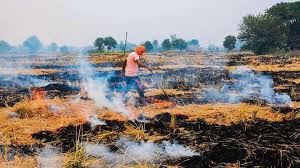What Is Stubble Burning?

With wheat yield down this year, the rate of tudi is very high and farmers can earn huge profits by selling it. But despite that, 3,895 field fires have been reported from April 1 to April 29 in Punjab.
- Farmers opt for stubble burning because they do not have alternatives for utilising them effectively.
- The farmers are ill-equipped to deal with waste because they cannot afford the new technology that is available to handle the waste material.
- With less income due to crop damage, farmers are likely to be inclined to light up their fields to cut costs and not spend on scientific ways of stubble management.
- Stubble burning is a common practice followed by farmers to prepare fields for sowing of wheat in November as there is little time left between the harvesting of paddy and sowing of wheat.
- Stubble burning results in emission of harmful gases such carbon diaoxide, sulphur dioxide, nitrogen dioxide along with particulate matter.
Advantages of stubble burning:
- It quickly clears the field and is the cheapest alternative.
- Kills weeds, including those resistant to herbicide.
- Kills slugs and other pests.
- Can reduce nitrogen tie-up.
Effects of Stubble Burning:
- Pollution: Open stubble burning emits large amounts of toxic pollutants in the atmosphere which contain harmful gases like methane (CH4), Carbon Monoxide (CO), Volatile organic compound (VOC) and carcinogenic polycyclic aromatic hydrocarbons. They may eventually cause smog.
- Soil Fertility: Burning husk on ground destroys the nutrients in the soil, making it less fertile.
- Heat Penetration: Heat generated by stubble burning penetrates into the soil, leading to the loss of moisture and useful microbes.
Chhattisgarh Model:
- An innovative experiment has been undertaken by the Chhattisgarh government by setting up gauthans.
- A gauthan is a dedicated five-acre plot, held in common by each village, where all the unused stubble is collected through parali daan (people’s donations) and is converted into organic fertiliser by mixing with cow dung and few natural enzymes.
- The scheme also generates employment among rural youth.
- The government supports the transportation of parali from the farm to the nearest gauthan.
- The state has successfully developed 2,000 gauthans.




